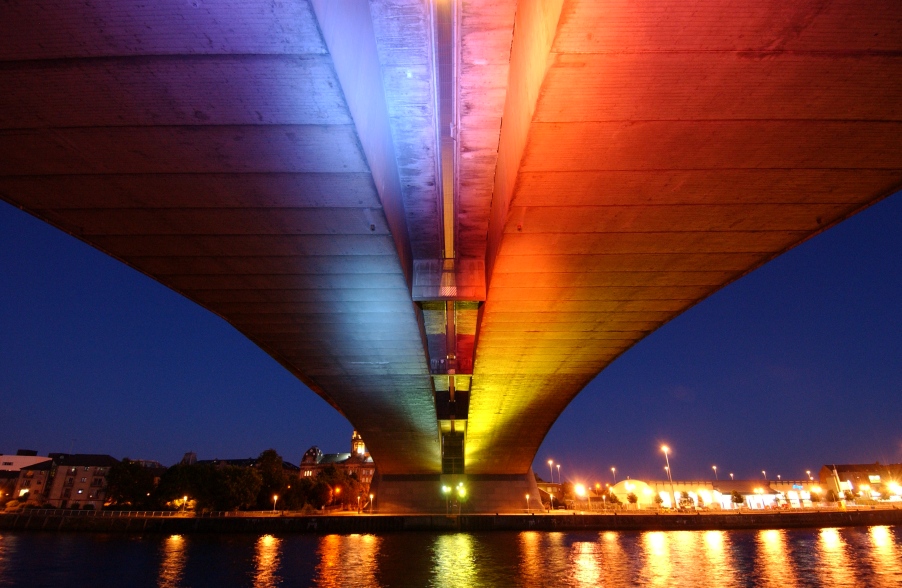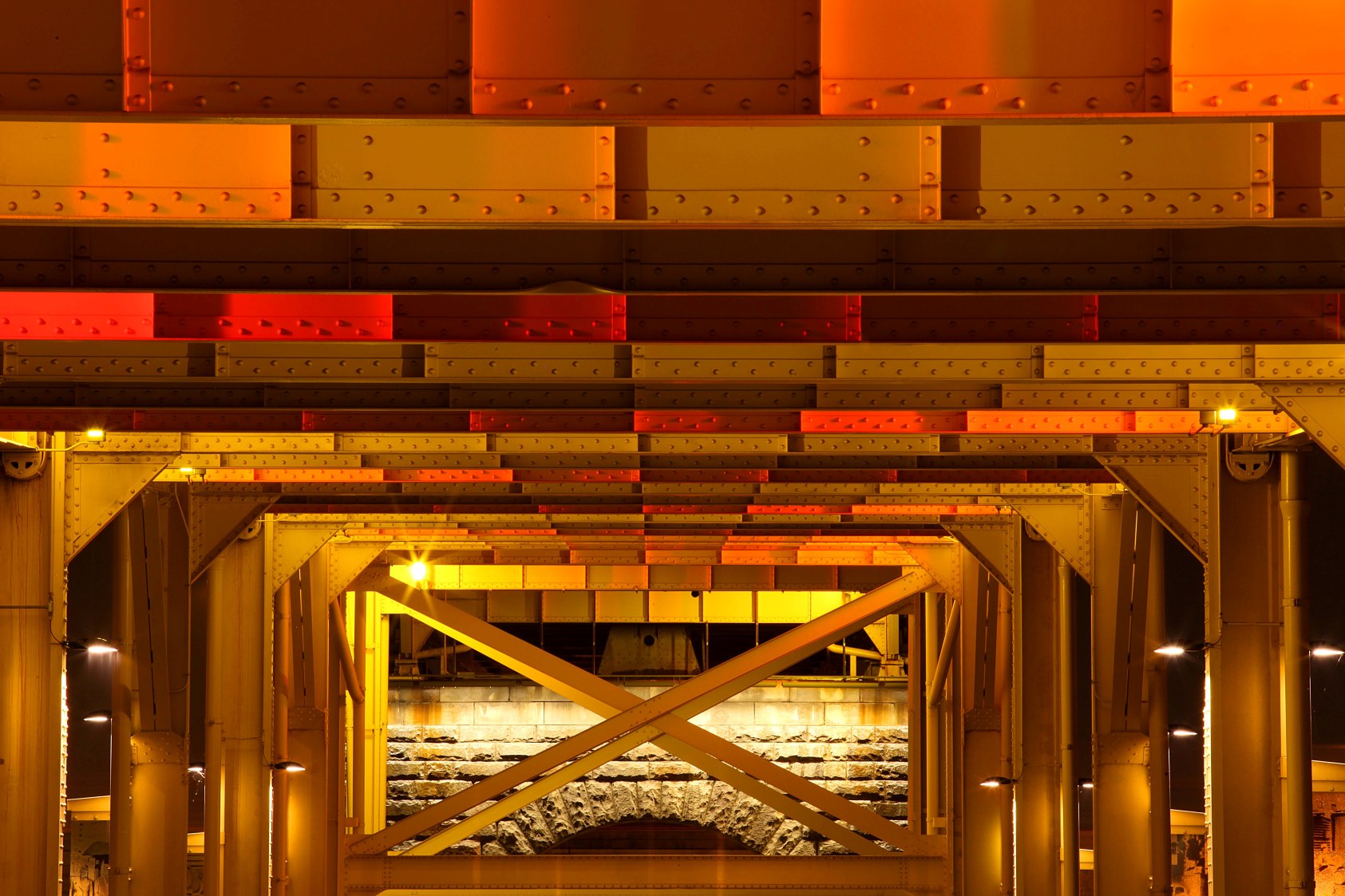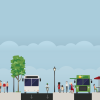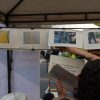Bogotá’s Metro line, a 25-km elevated structure already reshaping the city’s dense urban fabric, is now more than halfway complete. While most attention is focused on the infrastructure above, far less thought has been given to what will unfold below. These vast underpasses, covering up to 500,000 square meters, will cast not just physical shadows, but spatial and social ones, transforming how residents move through, perceive, and inhabit their city.
So far, no systematic public discussion has addressed the safety of the spaces beneath the 14-meter tall viaducts, particularly with regard to lighting. This absence of dialogue is concerning, especially in a city where public safety and perceptions of insecurity are urgent. From Chicago to Delhi, New York to Tokyo, we’ve seen that the spaces beneath elevated infrastructure, if left unplanned, quickly become neglected, insecure spaces: dimly lit, poorly integrated, and stigmatized.[1]

Bogotá stands at a crossroads. These shadowed spaces could become long-term liabilities: lifeless corridors that erode community trust, generate fear, and degrade the Metro’s public image. Or, if treated with imagination and care, they could transform into one of the system’s greatest assets: a network of intimate, connected plazas and pedestrian pathways at a human scale.
Lighting will play a decisive role in shaping this outcome. It is not merely a technical issue, but a deeply social and symbolic one, with implications for equity, inclusion, and the everyday rhythms of urban life. Done well, lighting beneath the Metro could invite presence, support movement, and reflect local identities. Done poorly, it risks becoming another generic, alienating piece of infrastructure that fails the communities it cuts through.
As Bogotá undergoes this once-in-a-generation urban transformation, a key question emerges: What kinds of spaces are we creating beneath the Metro? Will lighting merely reconfigure the shadows—or will it activate memory, connection, and care? How can light become a medium for equity, imagination, and collective belonging?
The Problems with Business-as-Usual
In Bogotá, as in many cities, lighting is still treated as a purely technical fix: more lumens, more poles, more standardized LEDs. This approach rests on the assumption that brighter automatically means safer—a logic that prioritizes quantity over quality. But in practice, this approach often results in overexposed, sterile spaces that feel neither safe nor welcoming.
As scholars like Nicole Kalms have emphasized, more light is not always more secure, particularly for women and other marginalized groups.[2] In fact, excessive or poorly placed lighting can backfire, creating disorienting contrasts between bright and dark zones, or sterile, clinical environments that feel uncomfortable and exposed. The perception of safety, in other words, depends not just on the presence of light, but on how it is designed, how it interacts with the environment, and what it invites.
This misalignment between lighting design and perceived safety stems from a failure to consider the qualitative dimensions of light, including color, layering, diffusion, and integration with its surroundings. Cooler white LEDs, now ubiquitous in cities, are perceived as harsh and hostile. In contrast, warmer, layered tones evoke feelings of safety and calm. Welcoming nighttime lighting has the power to transform not just the look of a space, but its emotional and social character.
The “quantity over quality” approach also brings unintended side effects. Light trespass, or the uncontrolled spillage of artificial light into homes and habitats, disrupts circadian rhythms, affects local wildlife, and erodes nighttime ecologies. What begins as an effort to increase safety can ultimately undermine quality of life for the very communities the infrastructure is meant to serve.
Lighting as Cultural Infrastructure
Thoughtfully designed lighting is more than functional, but also spatial, emotional, and cultural. It can guide movement, invite interaction, and tell stories. It can enhance textures, preserve memory, and make people feel seen. Urban lighting, when designed with care, doesn’t erase a neighborhood’s identity, but elevates it. It connects people to place through sensory experience, memory, and narrative. Light becomes a medium of belonging, which is an often-overlooked but fundamental quality of public space.
Leni Schwendinger, a pioneer in nighttime urbanism, has long championed this social and symbolic power of light. Her rigorous design process, with her Light Projects team (LSLP) begins with community workshops and nighttime explorations to identify local needs and values. Her “NightSeeing™” walks invite residents to reimagine their cities after dark—observing reflections, shadows, and emotional landscapes that daylight planning often ignores. Through this work, Schwendinger shows how lighting can foster empathy, enchantment, and participation.

In Evanston, United States, Schwendinger transformed eleven underpasses into a “corridor of light,” stitching together previously disconnected urban spaces. In Louisville, her lighting design under the George Rogers Clark Memorial Bridge used warm tones and movement to create a safe and engaging space for pedestrians and cyclists. Projects in New York and Glasgow have reclaimed transitional zones, using subtle lighting cues to build identity, intimacy, and intrigue.
Schwendinger’s work has also taken root in Colombia through collaborations with Despacio in Medellín, Getsemaní, and Bogotá, exploring the emotional and cultural dimensions of nighttime lighting through participatory processes.
Bogota’s Metro: Urban Rooms of Luminous Color
Building on this legacy, Bogotá has the opportunity to set a global precedent. Rather than defaulting to generic LED floodlights, the city could launch a participatory design process to illuminate the Metro’s underpasses—creating unique, safe, and beautiful “Urban Rooms of Luminous Color.” Despacio and LSLP’s approach treats local knowledge not as supplemental, but as foundational to good design. Through engagement workshops and nighttime walks, residents surface localized needs and co-define project goals. The resulting lighting design becomes a collective expression of community care, identity, and public life.
Reimagining lighting is not just a question of aesthetics, but a strategic social investment. Following a rigorous design process, lighting designers collaborate with maintenance teams and long-term operators to produce systemic, adaptive lighting designs that can reduce energy use, minimize vandalism, extend fixture lifespan, and streamline upkeep. But perhaps the most compelling case for thoughtful lighting design is emotional: cities flourish when their public spaces are safe, cared for, and beautifully lit. The spaces under elevated infrastructure should be as welcoming and vibrant at night as they are during the day.

Without rethinking our assumptions about lighting, and without a shift toward more nuanced, human-centered design, Bogotá risks repeating the same mistakes that many cities are now working to undo. The consequences are not just unappealing public spaces, but the reproduction of unequal and exclusionary urbanism. If Bogotá lights its Metro corridor using conventional means, the result could be a 25-kilometer strip of visual pollution, intrusive glare, and alienating space that divides the communities rather than connecting them.
With bold vision, Bogotá could set a new global benchmark: a 25-kilometer corridor of “Urban Rooms of Luminous Color” that redefines how cities light, connect, and care for their public spaces. By treating light as a cultural and emotional infrastructure rather than a technical afterthought, Bogotá could illuminate not just the Metro, but a new model for urban public space design across Latin America. With global attention on the city and local communities ready to engage, the question is not whether Bogotá will light the Metro — but how, and for whom.
Author contributions
- Sydney Coldren: Writing – original draft.
- Carlos Felipe Pardo: Review & editing.
- Lina López: Review & editing.
- Leni Schwendinger: Review & editing.
- Ted Tarquino: Header Photo
[1] See Su, Jing. 2005 and Alex, Dona. 2021.
[2] Kalms, Nicole. 2019. “More Lighting Alone Does Not Create Safer Cities. Look at What Research with Young Women Tells Us.” The Conversation. May 28, 2019









Comentarios recientes